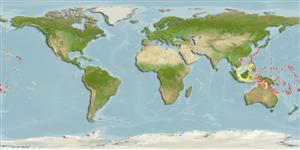Common names from other countries
>
Gobiiformes (Gobies) >
Gobiidae (Gobies) > Gobiinae
Etymology: Trimma: Greek, trimma, -atos = something crushed (Ref. 45335); kitrinum: Name from the Greek ‘kitrinos’, meaning ‘citron-yellow’ or ‘of citron’, referring to the distinctive yellow caudal fin of the new species..
Environment: milieu / climate zone / depth range / distribution range
Ecologia
marinhas associadas(os) a recifes; intervalo de profundidade 1 - 36 m (Ref. 100726). Tropical
Western Pacific: Indonesia, Australia and certain island groups north to Guam, south-east to Fiji and Samoa.
Tamanho / Peso / Idade
Maturity: Lm ? range ? - ? cm
Max length : 2.7 cm SL macho/indeterminado; (Ref. 100726); 2.5 cm SL (female)
Descrição suscinta
Chaves de identificação | Morfologia | Morfometria
Espinhos dorsais (total) : 7; Raios dorsais (total) : 8; Espinhos anais: 1; Raios anais : 8. This species (of Trimma tevegae group) is distinguished by the following characters: D VI + I,8; A I,8; pectoral-fin rays 13-14 unbranched; total gill rakers on the outer side of the first gill arch usually 20-22; 3-4 papillae in a transverse row at the posterior interorbital position of row p, and 3-5 papillae in a transverse row at the anterior position of row p; this transverse row usually extends anterior and lateral to the anteriormost papilla in row r; brownish body and bright yellow caudal fin, with no dark marking on the posterior part of the caudal peduncle (Ref. 100726).
Ciclo de vida ou comportamento de acasalamento
Maturities | Reprodução | Spawnings | Egg(s) | Fecundities | Larvas
Winterbottom, R. and D.F. Hoese, 2015. A revision of the Australian species of Trimma (Actinopterygii, Gobiidae), with descriptions of six new species and redescriptions of twenty-three valid species. Zootaxa 3934(1):001-102. (Ref. 100726)
Status na Lista Vermelha da UICN (Ref. 130435)
CITES (Ref. 128078)
Not Evaluated
Ameaça para os humanos
Harmless
Uso pelos humanos
Ferramentas
Relatórios especiais
Baixar XML
Fontes da internet
Estimates based on models
Preferred temperature (Ref.
115969): 24.9 - 29.4, mean 28.3 (based on 1139 cells).
Índice de diversidade filogenética (Ref.
82804): PD
50 = 0.5000 [Uniqueness, from 0.5 = low to 2.0 = high].
Bayesian length-weight: a=0.01023 (0.00477 - 0.02194), b=3.02 (2.84 - 3.20), in cm Total Length, based on LWR estimates for this (Sub)family-body shape (Ref.
93245).
Resiliência (Ref.
120179): Elevada, tempo mínimo de duplicação da população menor que 15 meses (Preliminary K or Fecundity.).
Fishing Vulnerability (Ref.
59153): Low vulnerability (10 of 100).
